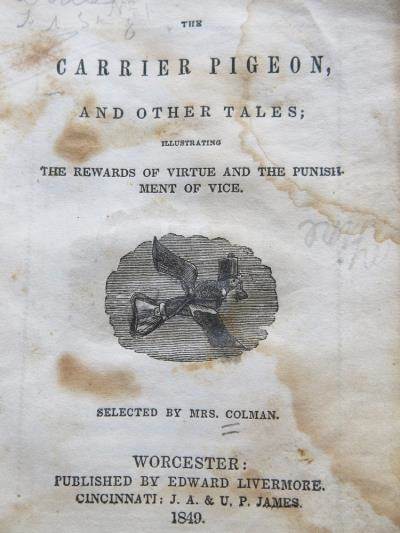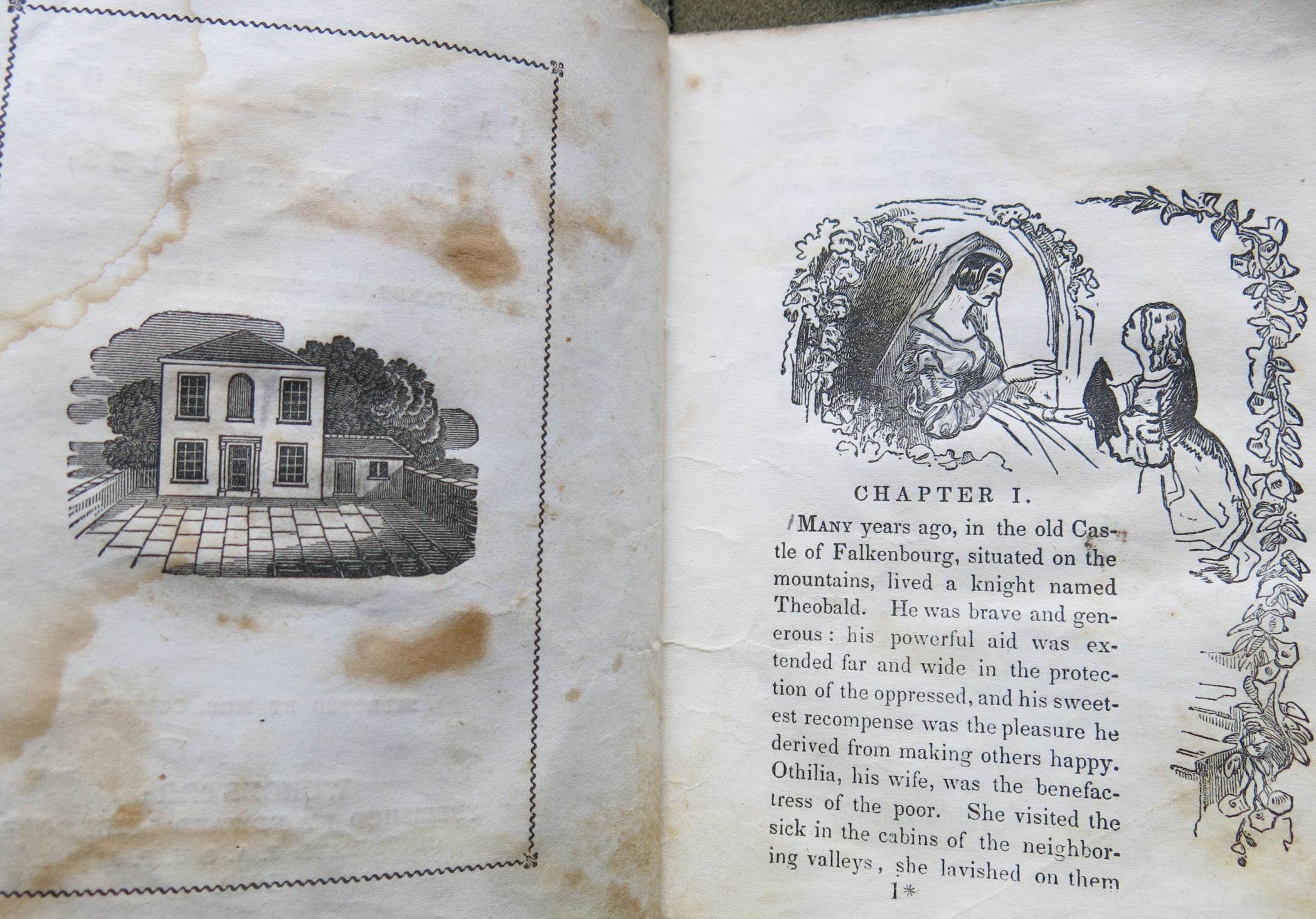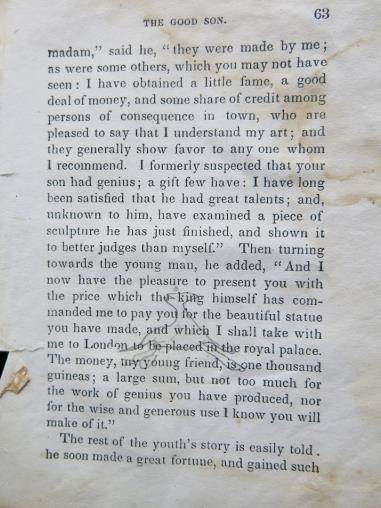By Brendan Kieran, Reader Services
I initially came across The Carrier Pigeon and Other Tales: Illustrating the Rewards of Virtue and the Punishment of Vice, selected by Mrs. Pamela Chandler Colman (Worcester, 1849), in an effort to find materials relating to pigeons at the MHS. However, I ended up utilizing this collection of children’s stories as a jumping point into a look at children’s literature and children in the 19th-century United States. Through my reading, I began to gain some insight into the roles of children and themes represented in literature during this period.

The titular story of this book is set in the German countryside, seemingly in the medieval or early-modern period. A girl named Agnes comes into contact with a dove, which she decides to take in. Through the advisement of her mother, Othilia, Agnes turns the actions of the dove into lessons for her behavior, becoming a more obedient, hygienic, and organized girl in the process.
One day, a woman named Rosalind and her daughter, Emma, show up at the castle of Sir Theobald (Agnes’s father) looking for help; using her care for the dove as an example, Agnes encourages Theobald to take in the visitors. Later, once Rosalind and Emma have returned to their castle, two men show up at their house; unbeknownst to them, but later discovered by a servant named Leonardo, the men are robbers looking to steal from and murder Theobald and his family. Emma comes up with the idea of flying the dove with a note attached to it to warn Theobald and the family of the motivations of the robbers. Ultimately, it is successful, and the plan is thwarted.

The second story, “Ingratitude,” is about a young girl named Helen and Mrs. Everhold, a woman who takes care of Helen. When Helen’s mother dies, Mrs. Everhold is given responsibility for raising Helen. Everhold tries to teach her skills and a strong work ethic, but Helen decides to act out, eventually turning to working for a baroness and not being there for Everhold when she becomes ill and unable to work. Helen eventually marries a violent and abusive man, and when he dies in an accident, she goes to Mrs. Everhold for help. Helen apologizes for her past actions; going forward, she is good to Mrs. Everhold, who ends up living a long life.
The final story is “The Good Son,” attributed to Rev. E. Mangin. After the death of her husband, a woman and son go to live with another family. The son, after displaying artistic ability, begins to train with a nearby mason. Ultimately, he receives awards for his work, providing new financial stability for himself and his mother. After becoming successful and notable as a sculptor, he continues to be good to his mother, the man who discovered him, and the family with whom he had lived.
All three of these stories have similarities that live up to the subtitle of the book. In “The Carrier Pigeon,” the dove serves as a symbol of virtue, imbued with overt religious connotations; to be like the dove is to be pure and respectful of God. The dove even serves as the means by which Rosalind and Emma are able to save lives. In “Ingratitude,” while Helen is disrespectful for much of the book, she ultimately turns to “proper” behavior toward a woman who took care of her, with suggested positive results for Everhold’s longevity. In “The Good Son,” the boy demonstrates hard work, creativity, and respect for the people who fostered his success. All of the children serve as lessons, indeed, on “the rewards of virtue and the punishment of vice.”

However, the stories do have some notable differences that raise questions regarding the audience of the book and the roles of class, gender, and race in 19th-century children’s literature. For example, the families in “The Carrier Pigeon” seem to be quite wealthy and of the nobility; however, the subjects of the other stories struggle with financial insecurity. There also seems to be an implication that girls are especially in need of lessons regarding proper morality. While the girls in “The Carrier Pigeon” learn lessons through the dove, and Helen in “Ingratitude” only learns good behavior after misfortune hits her, the boy in “The Good Son” seems to be good and respectful all along. It is men (the robbers) who exhibit most of the immorality in “The Carrier Pigeon,” and Helen’s abusive husband in “Ingratitude” is not a model of good behavior, but the process of learning lessons and correcting behavior seems to be more apparent in the women and girls in this book than in the men and boys. Racialized language seems to be a factor in “The Carrier Pigeon,” with the whiteness of both Agnes’s dresses and the dove deployed to represent good morality and cleanliness. This analysis is brief and tentative, but it hopefully notes the potential significance of this resource to scholars of race, class, and gender in 19th-century United States children’s literature.
I consulted our copy of Karen Sánchez-Eppler’s Dependent States: The Child’s Part in Nineteenth-Century American Culture (University of Chicago Press, 2005) in the hopes of learning a bit more about children’s literature in the 19th-century. Sánchez-Eppler offers some conclusions about children and literature of the period. The author notes the role “of teaching morals and forming character” in primers of the period, and notes the “variation on the basis of class, region, gender, and race” in conceptions of childhood in the 19th century, including the connection between leisure and a middle-class living. Sánchez-Eppler also notes the desirability of “submissiveness” for girls in 19th-century temperance literature of the period; the literature suggested – often using references to incest – that these qualities in girls would help their fathers overcome alcoholism and become better people. This literature has class connotations, as well, with children representing middle-class norms in some temperance works. Later, the author draws connections between race and the proper, domesticated behavior of children in 19th-century Sunday School works; these themes served as components of imperialist and colonialist projects. There is much more to Dependent States than what I’ve included here, and Sánchez-Eppler’s scope of analysis is broader than strictly children’s literature, but these ideas offer some insight into the complex roles constructed for children in literature of the period.
The MHS library is open for anyone who would like to view any of our available print materials. In addition, an 1851 copy of this book is available electronically through Internet Archive.

